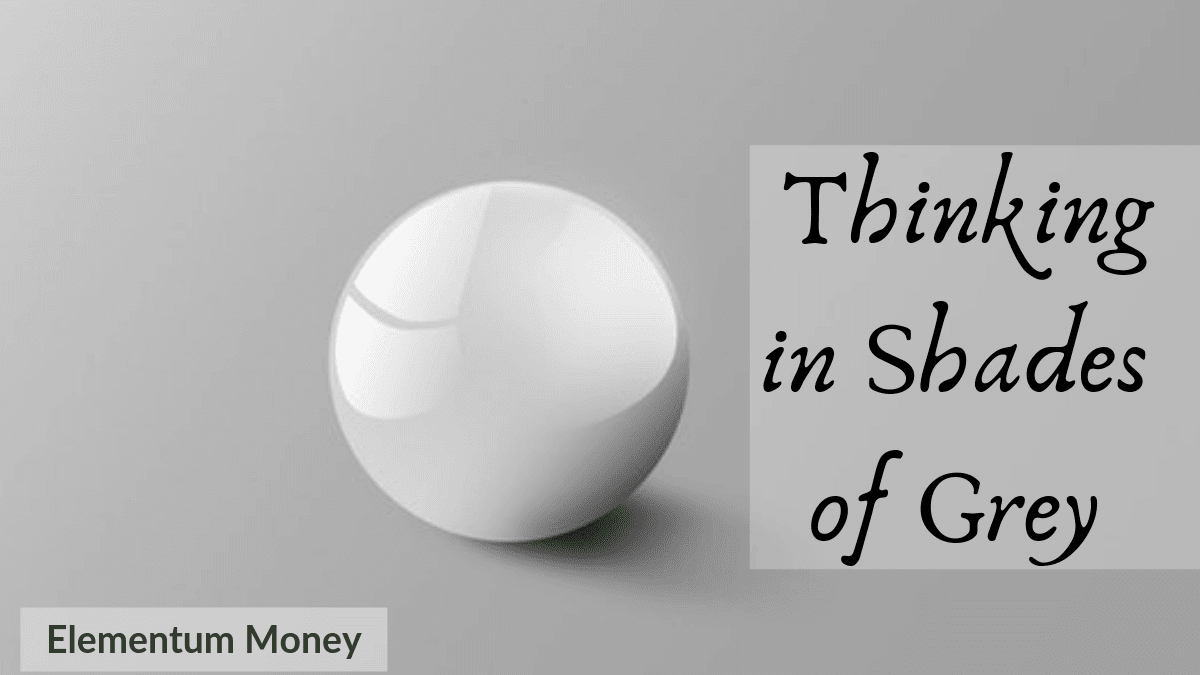There was a time when “shades of grey” was an innocent enough phrase. Now with E.L. James and her bestselling trilogy, on hearing the words, most people’s thoughts run pretty wild! However, the value of thinking in shades of grey in today’s highly polarized times only keeps increasing. Today, on any topic, there are enough people shouting themselves hoarse or writing until the ink runs out to prove how one side is the only viable way to look at a situation. For a large part of my life, I was prone to this behavior too. Things are right or wrong and I could have enough reasons to say just why it is so. I like to believe that as a person, I have grown and evolved over the years and time has smoothened out some of those rough edges.
My experience with thinking in grey
I have always been fascinated with history. Though like a lot of things in life, I enrolled myself in graduation with a specific goal in mind, which was to decipher the Harappan script. While that did not happen and my paths changed multiple times, what those three years did was give me a foundation to the idea of thinking in grey.
The first year, one of the most frequent advice from our lecturers was to forget how history was taught in school. So, in college, history was no longer about X happened followed by Y and then Z and this is the only way to look at things. History was more about event A and then understanding a minimum of 3 or 4 views about it, through varied angles.
This way of seeing the same thing through different colored lenses gave it a far richer and more colorful prism than seeing it through the straight line of a conventional string of facts or one-sided view that history was always made out to be.
This skill with the foundation laid in those three years has now been consistently honed with a voracious hunger for reading and a conscious effort to continue to try and absorb different viewpoints.
What does thinking in shades of grey mean?
Has this been confusing so far? Especially talking in colors. Let me back up a bit and go back to the basics.
Let’s take an example here. Think about Mahatma Gandhi, the father of the nation. I still remember we had months of debates about him in our final year of graduation, being a part of the Modern India paper. For most of us, we revere and worship him, putting most of the credit for the Indian freedom movement at his feet. That means when it comes to Gandhi as a person, he is all white.
But is that the whole picture? Was everything about him as perfect as we choose to believe? What about his personal relationships and the people whose back he was supposed to have. Considering the sensitivity of the topic, I will use the convinient route of linking this article which mentions 10 controversies about Mahatma Gandhi that should serve as food for thought.
After looking at such possible aspects which have probably been written out of history, how do you view Mahatma Gandhi now? Do you still paint him all white as the paragon of all things perfect or is his character to now be viewed as completely black? Or is he now looking more human who had his own shortcomings even as he led the country to freedom, making his character a mix of black and white and a particular shade of grey?
Why is thinking in shades of grey important?
You might wonder, that in this world where having opinions is almost a mandate, black and white thinking works far better. The more polarized, impassioned an opinion, easier to shout it down the table at the next social outing. Not just that, our brains find it far easier to reduce the world into binary options – good or bad? Love or hate? Friend or enemy? Right or wrong? As Kahneman put it in his widely touted book “Thinking Fast and Slow”, we would rather take the easier route of thinking fast and settling on one of the two options presented by the binary thinking that viewing the world in black and white brings with it.
However, once you start having a balanced view of things, people and matters, by seeing the shades of grey that they come in, you will start seeing the value of it. Some of the benefits that immediately come to mind are:
Helps with a broader mindset
When we think in extremes, it’s a short path to polarization and well, intellectual doom. Okay, I am being extreme here now. But the point I am trying to make here is that when we think in extremes, it is like living our lives with blinders. We essentially give up on the idea of potential ambiguity and end up being rigid in our minds, with no room for any flexibility per se.
While Buddhism is the only religion synonymous with the idea of the middle path, in my experience thinking in extremes becomes problematic in the long run. Looking at the broader picture while thinking in grey is a useful habit for life.
The world really is grey
When you start thinking in terms of grey, in a way you are acknowledging the fact that the world really works in shades of grey. Almost anything that you can see around you, will have good and bad aspects to it.
For instance, I detest and hate the idea of organized religion. In my view, all it does is really divide people and give a convenient means for discrimination and killing. However, even with such a strong view, I can really not deny the way it brings people together in pockets and also provides solace as well as hope to people who really buy that dope. (Yes, I am still a work in progress when it comes to thinking in grey, at least on some aspects)
Makes you more tolerant with people and the world in general
This to me is a big benefit. When you consciously want to think in grey, you will open up to people, mindsets, opinions and the world in general. You will start internalizing the fact that a person that you detest might actually have qualities worth learning from. You will probably begin to rationalize how almost every dark situation comes with its own silver lining.
In some ways, that’s what makes me want to stick to living in India. So many people around me talk about how difficult life can get here and how much easier it would be to jump countries. When I think of it, yes living in India comes with its challenges but it’s foolish to think that emigrating is a cakewalk either. Both the options will be grey and all you get to do is choose a shade which works better for you.
How can you improve your skills of thinking in shades of grey?
Considering thinking in binary terms of black and white is easier for the reductionist tendencies of our brain if you are really looking to change it, it will require conscious efforts. Over time, chances are that your default setting will change to grey. Try some of the below suggestions to start on your quest of changing the color of your thoughts.
Question long-held beliefs or opinions
A lot of times, we hold beliefs and opinions for years which end up defining our mindset for the future as well. For instance, I used to eat chicken and fish happily as a kid and then one fine day I suddenly turned vegetarian because I decided I did not like the taste.
Some years back, when I decided to do strength conditioning on a regular basis, I was told by a lot of people how chicken is one of the best sources for the required quantum of protein. So while I am still unsure of whether I like the taste of it or not, I eat it almost on a daily basis to get the best of my workouts.
Sometimes, extreme beliefs exist in our minds and lives for the sole reason that they have not been questioned or have not found a reason to be turned. Once you start examining them, your appreciation for thinking in grey is only going to increase.
Consciously seek out diverse opinions
As we grow with varying influences from all around us, we form opinions about things all and sundry. Gradually, we also seek affiliation with people, content and cultural influences that reaffirm those views, forming and strengthening our personal echo chambers. I think you can guess where I am going from here, to say that it only accentuates our biases and leads far more strongly to the tendency of binary thinking. Today, it requires a conscious effort and seeking out for diverse multi-faceted opinions to cultivate a broader mindset and to think in shades of grey.
For instance, when Article 370 for Kashmir was revoked, there were enough people around me having an overwhelming opinion for or against. I, for one, chose to conclude that it is a complex issue which would have both sides to it, the potential good and the possibly problematic. I told myself that I would wait to read more views from people who had a better insight on the matter to really form an opinion. Even today, I look to read different angles to have a more balanced opinion rather than euphoria or disappointment.
Watch your voice and inner voice
Ever watched your words or even your inner voice? (Side note, if you don’t talk to yourself, you are the weird one and not me for assuming everyone does!). A lot of our thinking gets reflected in the words we use.
For instance, “this is the worst hotel in the world” were memorable words used by my then 6-year-old nephew for one of the hotels we checked into on our last family holiday. Granted, it was honestly horrible but when you start forcing yourself to start thinking in greys, the easiest way is to tone down the binary aspect in your vocabulary.
In this regard, I came across this really interesting vocabulary exercise at Psych Central to see if you can even find the middle path in so many extremes that we take for granted. I failed miserably but give it a shot for your own eureka moment.
When you move away from the precarious see-saw of binary thinking to embrace the balancing act that thinking in grey involves, you will appreciate the world it opens up.
How do you think? Black and white or shades of grey? Let me know in the comments below.





Leave a Reply